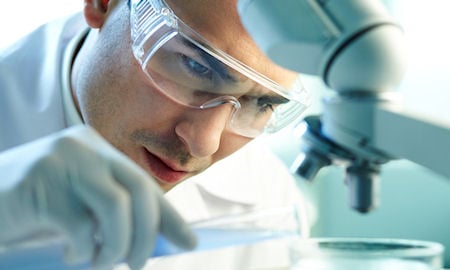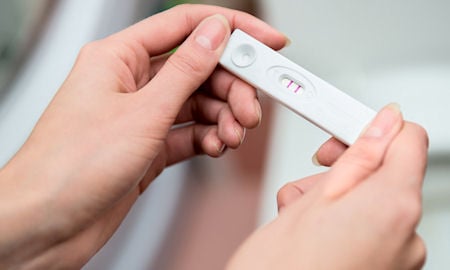
Gonadotropin Stimulation
Repronex (HMG), Bravelle, Follistim, Gonal F, Follistim AQ Pen, and Gonal-F RFF Pen (FSH) are injectable hormones which are chemically identical to the natural pituitary hormones that control ovulation and may be produced by synthesis or extraction from the urine of postmenopausal women. These natural hormones are used clinically for the stimulation of follicle and egg development in the ovary. Their use is not associated with evidence of teratogenicity (abnormal development in the baby). A further advantage of these drugs is that they do not require normal hormone production by the hypothalamus or pituitary for their action. Therefore, they can be used in a patient with underactive pituitary production of the hormones that normally stimulate ovarian or testicular function.
SIDE EFFECTS
Ovarian Cysts: Ovarian cysts (sacs of fluid within the ovary) are common with these medications. Usually these cysts resolve spontaneously, although they may cause some temporary pelvic pain. Rarely these cysts may rupture, bleed, or twist and require surgery.
Hyperstimulation of the ovary during gonadotropin therapy: In order to minimize the hazard associated with the occasional abnormal ovarian enlargement associated with these drugs, the lowest dose of medication consistent with an expectation of good results is used. Careful monitoring of ovarian response can minimize but not eliminate the risk of hyperstimulation. Mild to moderate uncomplicated ovarian enlargement frequently occurs with gonadotropins. This may be accompanied by abdominal distention and/or abdominal pain in about 20% of patient treated with these agents. These symptoms usually regress within two to three weeks.
Ovarian hyperstimulation syndrome: The ovarian hyperstimulation syndrome is associated with an exuberant ovarian response to HMG and FSH. This can occur in patients ovulating spontaneously or in women undergoing in vitro fertilization (IVF) or gamete intrafallopian transfer (GIFT). In this condition the ovaries enlarge and fluid leaks into the abdominal cavity (a condition called ascites). Fluid may accumulate around the lungs (called pleural effusion). It is estimated that severe hyperstimulation syndrome will occur in 0.4% - 1.5% of patients. With the increased dose of medication used for IVF, the incidence increases to approximately 6%.
When moderate to severe hyperstimulation occurs, a number of symptoms may follow. Hospitalization is usually required. Urine output may decrease as fluid is transferred into the abdominal cavity. This can affect normal kidney function, and efforts are taken to maintain an adequate urine output. In addition, the blood can become abnormally concentrated. This can cause blood clots which rarely travel to the lungs or other organs and can be life threatening. Treatment in the hospital decreases abnormal clotting and maintains the blood volume within the vessels. An imbalance in salts can also occur with this condition. Treatment is primarily symptomatic and consists of hospitalization, bed rest, fluid and salt replacement as needed. Severe ovarian hyperstimulation can cause strokes, kidney failure, heart attack, and even death, although these consequences are extremely uncommon with adequate treatment.
In any situation of ovarian enlargement, bleeding can occur from ruptured ovarian cysts. Therefore, during gonadotropin cycles, intercourse and extensive abdominal or pelvic examinations are discouraged more than three days after the hCG shot.
Blood clots in the arteries or veins: Arterial thromboembolism (blood clots in the vessels) has been reported in four patients over the years HMG has been used, and deaths were noted in two of these women. This condition is most often associated with ovarian hyperstimulation syndrome and measures are taken during hospitalization (if required) to minimize this risk.
Multiple births: Of the pregnancies following therapy with HMG, 80% have resulted in single births and 20% in multiple births most of which have been twins. According to the literature supplied by the company that manufactures HMG, 15% of the total pregnancies result in twins, of which 93% are viable. Five percent of total pregnancies resulted in three or more fetuses. In addition, the aggressive use of Bravelle, Repronex and for women with difficult ovulation also increases the risk of multiple births. Multiple gestation poses an increased risk for both mother and baby. For the mother, there is an increased chance of hypertension, blood clots, preterm labor, toxemia, and other pregnancy complications. For the babies, there is an increased chance of prematurity and associated problems, and a slight increased risk of birth defects.
UTILIZATION OF HMG
HMG and FSH are administered as an injection. They may be given once or twice a day, sometimes in combination with other medications. The use of Bravelle, Repronex, Gonal F, Follistim, Follistim AQ Pen and Gonal-F RFF Pen must be monitored with serial estrogen levels (blood tests) and ultrasound scans. These two tests together depict the maturation of the follicles containing the oocytes and help assess the risk of multiple pregnancy and hyperstimulation.
ADMINISTRATION OF hCG
The hormone hCG (human chorionic gonadotropin) is given as an injection when the follicles are mature. The hCG is given to complete maturation of the egg and release of the egg (ovulation) from the developing follicle. Ovulation usually occurs 36 - 40 hours after hCG injection.
Since withholding the hCG injection limits the risk of severe hyperstimulation syndrome, hCG will be withheld and ovulation will not result if an exuberant ovarian response occurs. This is manifested by a very high estradiol level and multiple dominant follicles noted on ultrasound scan. Hyperstimulation syndrome following hCG administration is more common when pregnancy is achieved, and the incidence may increase further if multiple births are produced.
Some tenderness and enlargement of the ovaries is common 4 to 7 days after hCG administration. This usually resolves with the following menstrual period if pregnancy does not occur. hCG is the hormone which is detected in pregnancy tests. Therefore, the performance of a test within 10 days after hCG administration may falsely suggest the presence of a pregnancy.
SYNOPSIS
Bravelle, Repronex, Follistim, Gonal F, Follistim AQ Pen and Gonal-F RFF Pen are very effective medications to induce follicular maturation and ovulation. Their expense and need for close monitoring must be balanced with their potential benefits.

